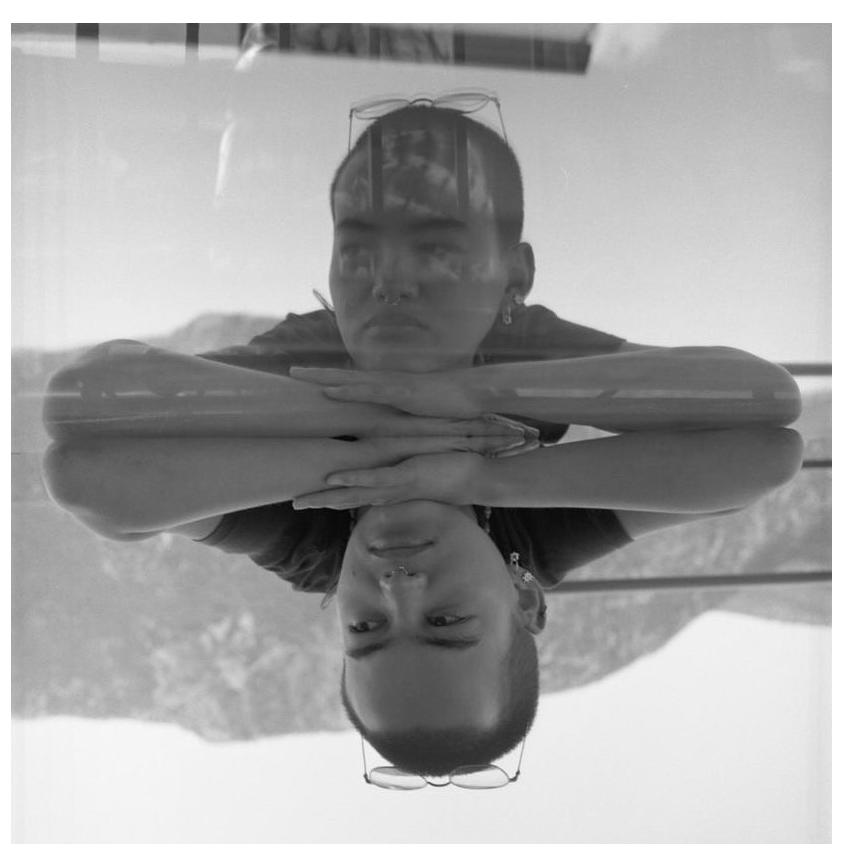
1996 年長野県生まれ、東京都育ち。ギリシャ・アテネでの留学を経て、2023 年東京藝術大学美術学部先端芸術科卒業。主に人種・ジェンダー等の人間の属性をめぐる世の中に対する問題意識をテーマに、フィクションとノンフィクショを往来するマルチメディア作品を制作している。舞台やパフォーマンスなど、領域を横断し幅広い活動も行っている。
Lio Karasawa Grabill (they/them) was born 1996 in Nagano, and raised in Tokyo. Karasawa Grabill graduated from the Department of Inter-Media Art, Tokyo University of the Arts in 2023, after studying abroad in Athens, Greece. They create multimedia works that move back and forth between fiction and non-fiction, mainly on the theme of Intersectional identities within race, gender and so on.
Website: emilykgportfolio.com
Instagram: @em__1_l_1__o
作品 Artwork
唐沢里央
パープルバック
2024
映像、ハンモックチェア
21分40秒
Lio Karasawa Grabill (they/them)
purple back
2024
Video, hammock chairs
21 min., 40 sec.
アーティスト・ステートメント / Artist Statement
(English follows Japanese)
本作は、2019年に展示されたサウンドインスタレーション「でも俺は絶対塗りたくなかったから 虹色に塗ったの。」の再制作であり、当時野外設置された作品を室内に持ってくる試みの中、作 家本人によるドラァグとリップシンクのビデオがつけられました。本作でのブラックルーツを持 たない作家本人のインテンションは、決して声の持ち主の兄弟になり変わろうというものではあ りません。どれだけ「白人男性」から遠いかといった指標の中で決定される傾向にある命名の中 で、インターセクトした人種やジェンダー等のアイデンティティの中からこぼれ落ちる、宙ぶらり んな動詞としてのクイアな状態の可能性を探る試みです。 作家・唐沢里央は16歳の頃にSNS上で、同じ父 親を持つ姉をアメリカに見つける経験を持ち ます。本作の声の主であるタニヤとジョーダンも同じ父親を持つ兄弟でありながら、10代後半に なってお互いを見つけた経験への共感から、録音したダイアログを発展し制作されています。 乱暴なタームによって一纏めにされることのあるミックスルーツを持つ日本人の中でも、1人ひと りが人種・国籍・ジェンダー・セクシャリティ・障がいの有無・経済的な状況等における交差的 なアイデンティティを抱えています。本人の姿が見えない音源の中で流暢な日本語を聞いた際、 ミックスルーツを持つ日本人の姿が鑑賞者の想像から抜け落ちること。その中でもブラックルー ツのある人々の存在が、そこからさらに抜け落ちること。さらに、声のトーンによってジェンダー に対する二元論的な想定が暴力的に起き続けることに関して、本作は鑑賞者が内在している偏見 による想定を覆し、飛び越える試みです。そしてバイレイシャルの日本人としても、ブラックルー ツを持たない作家本人が決して代弁出来ない、肌の色による経験の話を、リップシンクせずに退 場するシーンが意図的に設定されます。 2023年パレスチナでの状況が激的に悪化し、解放運動に携わるようになった後に本音源を聞き返 した作家は、兄弟の経験を語る上でアパルトヘイト政策と虐殺への加担によりボイコット対象の ファストフード店の名前がたびたび出てくることに気がつきます。口にテープを貼り意図的にリッ プシンクしないのは、虐殺を支援する大手企業の名前であり、ボイコットは今もなお続くパレス チナ人への民族浄化を止めるために呼びかけられ続けています。 ありとあらゆる抑圧の止まないパレスチナにおいては、アメリカにおける黒人の解放運動への連 帯をいち早く示したことが言われています。作品横に設定された「中庭」において、制作のリサー チに使用された書籍とに加え、世界中の抑圧が全て交差しているパレスチナ解放への連帯アク ションの場が用意されます。人種差別の終焉、クイアの解放は、パレスチナの解放無しには実現 できない。というメッセージの元、本展のために制作されたZINEやパッチの配布をします。4/5 にはシルクスクリーン、プラカード制作のワークショップを行った後に藝大陳列館から上野公園を サイレントマーチする予定です。 バイレイシャルでクイアな作家本人にとって、本展のタイトルに使用されている、場と場の境界と なる「敷居」とは、それがいつも自分自身の存在に課せられてきた交差的な立ち位置に関する実 感としての強烈なリンクがあります。また、ハードルとしての「敷居」(敷居が高い・低いなど) について考えた際にも、特に日本社会においてスティグマ化される人種やジェンダーをめぐるト ピックを、宙ぶらりんな状態で聴かせるための設定としてハンモックが用意されています。権威的 である「敷居」を踏む行為とはつまり、バイレイシャルである作家本人の存在そのものであり、 止むことのない男女二元論への抵抗でもあると捉えることが出来ます。
This work is a reworking of the sound installation exhibited in 2019, “But I never wanted to paint it, so I painted it rainbow.” that was installed outdoors at the time, and in an attempt to bring the work indoors, a drag and lip-sync video by the artist themselves was added. The intention of the non-black-rooted artist themselves in this work is never to become a sibling of the owner of the voice. It is an attempt to explore the possibility of queer status as a verb in limbo that spills over into naming, which tends to be determined by indices such as how far from ‘white male’ one is in terms of intersectional race, gender and other identities. The artist, Lio Karasawa Grabill, had the experience of finding their older sister, who had the same father, in the US on SNS when they were 16 years old. The voices of the film, Taniya and Jordan, are also siblings with the same father that found each other in their late teens. The recorded dialogue was developed and produced out of empathy for their experiences. Among Japanese people with mixed roots, who are often lumped together by violent terms, each person has an intersectional identity in terms of race, nationality, gender, sexuality, disability and economic status and so on. The image of a Japanese person with mixed roots can be lost in the viewer’s imagination when hearing fluent Japanese in a sound source where the person is not visible. The presence of people with black roots among them falls further out of it. Furthermore, dualistic assumptions about gender depending on the tone of voice occur violently and continually. The work is an attempt to subvert and jump over the viewer’s internalized prejudicial assumptions. And also as a bi-racial Japanese individual, the scene is deliberately set up to exit without lip-syncing to the story of the experience of skin colour, which the artist themselves, who has no black roots, can never speak for. After the situation in Palestine in 2023 deteriorates drastically and the artist becomes involved in the liberation movement, they realizes that the names of fast food restaurants to be boycotted due to their complicity in apartheid policies and genocide are frequently mentioned in the brothers’ experiences. What is taped to the mouth and deliberately not lip-synched are the names of major companies that support genocide, and boycotts continue to be called for to stop the ongoing ethnic cleansing of the Palestinian people. In Palestine, where all manner of oppression continues, it is said to have been one of the first to show solidarity with the black liberation movement in the USA. In addition to the books used in the research for the production, In the ‘Nakaniwa’ next to the work, there will be a space for solidarity action for the liberation of Palestine, where all the world’s oppressions intersect, in addition to the books used in the research for the production. The end of racism and the liberation of queers cannot be achieved without the liberation of Palestine. On 5 April, after a silk-screening and placard-making workshop, there will be a silent march from the Geidai through Ueno Park. For the bi-racial, queer artist themselves, there is a strong link with the ‘threshold’ used in the title of the exhibition, which is the boundary between place and place, as a realization about the intersectional standing that it has always imposed on their own existence. Also, when thinking about the ‘threshold’ as a bar (e.g. high or low threshold, 敷居が高い・低い), the hammock provides a setting for listening to topics around race and gender, which are stigmatized in Japanese society in particular, in a state of limbo. The act of stepping on the authoritative ‘threshold’, in other words, can be seen as the very existence of the biracial artist themselves, as well as their resistance to the unstopping gender dualism.
